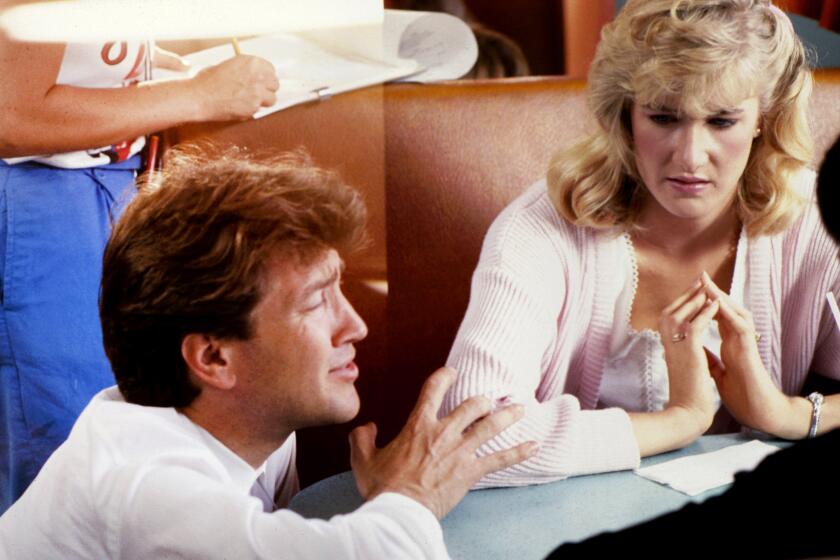The Invisible Powers-That-Be : Many Story Analysts Have a Much Better Grasp of the Elements Necessary to Make a Good Screenplay Than Do Their Bosses
- Share via
“Gaffers, Grips and Best Boys,” copyright 1987 by Eric Taub, will be published by St. Martin’s Press, Inc., in December 1987.
ONE OF THE most oft-repeated mistaken beliefs of fledgling screenwriters is that, having been signed by an agent, they have passed the major stumbling block to success and are now on their way to taking their rightful role in the film business. If the William Morris Agency is brilliant enough to recognize the true genius of this budding writer, can 20th Century Fox be far behind?
The answer, unfortunately, is yes. A contract with a literary agency often means little. Although an agent might see talent, there is no guarantee that anyone else along the lengthy chain of movie decision makers will as well.
It is easy to forget that hundreds if not thousands of people are simultaneously going through the same process--writing a script of sufficient quality to attract the attention of an agent and then trying to sell that screenplay to a production company. But with the exception of a few very well known or newly successful screenwriters, most everyone’s screenplay--no matter how well-written or how well-received by an agent, no matter how well-connected the writer or producer is to a highly placed studio executive--will have to go through the same production-company screening process. And that screening process begins, in almost every instance, with a reader.
The reader, more formally known as the story analyst, is the first way station along the road to a studio’s acceptance or rejection of a literary property. His or her role is to act as a filter for production executives whose schedules prohibit them from reading every script sent by anonymous agents or even personally given to them by close industry friends.
“Most writers generally deplore the idea of what we do,” notes Joe Davis, a veteran Hollywood story analyst for Lorimar Telepictures. “When you’ve spent four to six months laboring over a 120-page manuscript, it’s quite normal for you to fear, ‘What if the reader got up on the wrong side of the bed? What if he or she had a fight with their spouse? What if the reader read half of the script on a
Friday and the other half on a Monday? How do I know that I’m getting a fair shake from this reader on the evaluation of my script?’ ”
The answer is that one doesn’t ever know. When a dispassionate individual is swamped on a daily basis with more scripts than he or she can possibly read with the attention to detail that is
expected and necessary, mistakes are bound to occur. And there is no
question that those mistakes, when made, can be costly, dooming a project to oblivion or a writer to less recognition than he or she deserves.
“But this the only way yet devised to cope with the huge mass of written material that we must get through,” Davis says. “Our work is used as an aid for the studio decision makers. It’s a shortcut for them.”
The reader is the low man on the totem pole, the individual who sees virtually all submissions sent to a studio but who, ironically, has virtually no power to get any of them made into a film. “If we are negative about something,” Davis says, “it’s quite likely that nobody else in the company is going to take time to read it. They will trust (our opinion). If we are strongly positive about something, (the executives) will look at it. But it does not mean that our company is going to buy it.”
Fortunately for the studio executives, there are few scripts that readers get very excited about. The number of outstanding properties is minuscule. “To think that because almost all submissions come through a literary agency they are therefore of a highly professional nature would be incorrect,” Davis says. “The vast majority of submissions are average to mediocre.”
Davis reads and evaluates an average of seven to 10 scripts per week. “Perhaps one out of 10 is worth calling to the attention of the executives,” he says. “And maybe two or three times a year, in one script out of a hundred do I find myself really excited about something.” That excitement can come from the story itself, the way it is written or the “elements” attached to the project--the pledged involvement of a major star, director or producer.
Nearly all studios follow the same procedure in their story-coverage requirements. The front page of the reader’s report lists the name of the property, its author, the type of material, its length and its elements, if any. In addition, a two-sentence “log line” summarizes the story. The final statement on the front page indicates whether the reader recommends the work.
Attached to the first page is a separate two-page story synopsis. “If we find something that we’re really wild about, then we’ll write something longer to capture more of the flavor, the nuances of the story,” Davis says. Regardless of the length of the synopsis or the reader’s feeling about the literary property, the story analyst will make every attempt to be as objective as possible in his summary section of the report. For instance, the reader will write: “A wild chase ensues through Los Angeles”--rather than: “An amateurishly conceived wild chase ensues through Los Angeles.”
The analyst’s comments are reserved for the third section. It is here that the reader gets the chance to talk about the problems and strengths of the material, and whether it can work as a film. Even if the screenplay is not to be recommended, the reader might find that the writer has particular talents of which production executives should be made aware.
Despite the fact that many fledging writers fear that their material will get lost as it winds its way through the maze of agents, readers and production executives, the fact is that story analysts are, rather than a bored bunch of cynical slackers, a conscientious group of individuals, many aspiring writers themselves, who are devoted to searching out good work. And many of them have a much better grasp of the elements necessary to make a good screenplay than do their bosses.
Reprinted by permission of St. Martin’s Press.
More to Read
Only good movies
Get the Indie Focus newsletter, Mark Olsen's weekly guide to the world of cinema.
You may occasionally receive promotional content from the Los Angeles Times.










